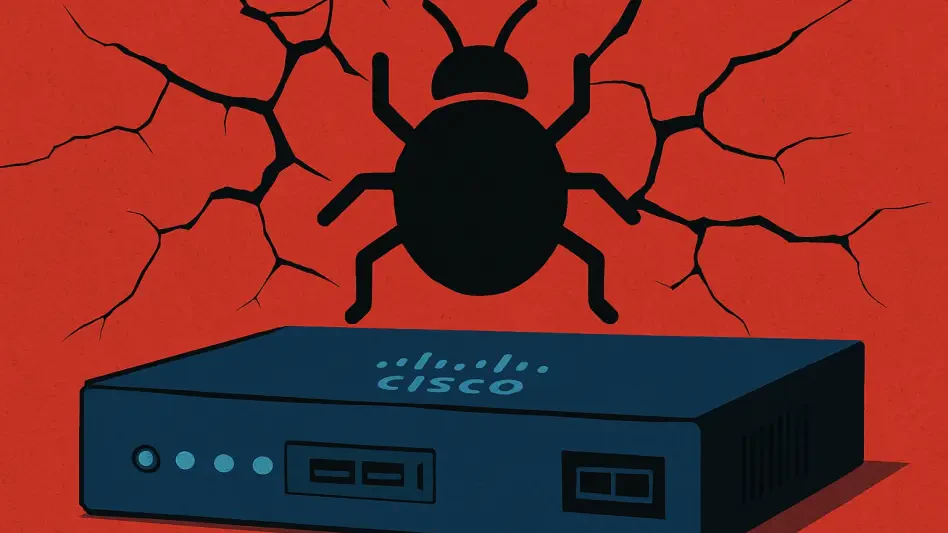In a digital landscape where cybersecurity threats loom larger than ever, a critical vulnerability in Cisco’s Secure Firewall Adaptive Security Appliance (ASA) and Secure Firewall Threat Defense (FTD) software has emerged as a pressing concern for organizations worldwide. This severe flaw, actively exploited by sophisticated attackers, poses an imminent risk of complete device compromise, potentially exposing sensitive data and internal networks to malicious actors. With remote work and secure access relying heavily on VPN services, the stakes couldn’t be higher for businesses and critical infrastructure alike. The urgency to address this issue stems from the near-maximum severity rating of the primary vulnerability and the real-world attacks already underway, signaling a need for immediate action to safeguard systems.
Understanding the Threat Landscape
Unpacking the Critical RCE Flaw
A zero-day vulnerability, tracked as CVE-2025-20333, has been identified in Cisco ASA and FTD platforms, carrying a staggering CVSS score of 9.9, which underscores its critical nature. This remote code execution (RCE) flaw, rooted in improper validation of user-supplied input in HTTP(S) requests, leads to a buffer overflow that authenticated attackers can exploit. With valid VPN credentials, threat actors can execute arbitrary code with root privileges, opening the door to installing backdoors or stealing critical data. The active exploitation of this vulnerability in the wild amplifies the danger, as it indicates that attackers, potentially including nation-state or advanced persistent threat (APT) groups, are already leveraging this flaw to compromise systems. Organizations relying on affected devices must recognize the gravity of this threat, as it directly targets the VPN web server component, a cornerstone of secure remote access.
Beyond the primary RCE issue, a secondary vulnerability, CVE-2025-20362, with a CVSS score of 6.5, compounds the risk by enabling unauthorized access. Stemming from inadequate access controls, this medium-severity flaw allows unauthenticated attackers to bypass authentication and interact with restricted URL endpoints. While its impact is less severe compared to the RCE vulnerability, it still broadens the attack surface, especially for devices with remote access VPN configurations enabled. This combination of flaws highlights a dual-layered threat to network security, where even less critical issues can serve as entry points for broader exploitation. The fact that no credentials are required for this secondary flaw makes it a concerning vector for opportunistic attackers seeking to gain a foothold in vulnerable systems.
Targeting Specific Configurations
Certain configurations of Cisco ASA and FTD devices are particularly at risk, especially those with AnyConnect IKEv2 Remote Access, SSL VPN services, and Mobile User Security (MUS) implementations enabled. Devices featuring SSL listen sockets are prime targets for crafted HTTP requests that exploit these vulnerabilities, making them susceptible to compromise. For the critical RCE flaw, attackers must first obtain valid VPN credentials to achieve root-level access, a step that underscores the importance of robust credential protection. However, the active exploitation observed suggests that such credentials may already be in the hands of malicious actors, heightening the urgency for organizations to reassess their security posture. The focus on VPN-related configurations reflects the critical role these systems play in enabling remote work, a reality that many businesses cannot easily disrupt without significant operational impact.
Adding to the complexity, the unauthorized access vulnerability does not require credentials, meaning any exposed device with the affected configurations could be targeted by attackers scanning for weaknesses. This broader attack surface poses a significant challenge for security teams, as it increases the likelihood of initial breaches that could escalate into more severe compromises if paired with other exploits. The specific targeting of VPN services also points to a troubling trend in cybersecurity, where infrastructure essential for secure communication becomes a focal point for sophisticated attacks. Organizations must prioritize identifying whether their setups fall into these vulnerable categories, as overlooking such details could leave critical systems exposed to ongoing threats in an increasingly hostile digital environment.
Mitigation and Response Strategies
Immediate Actions for Protection
Given the active exploitation of the critical RCE vulnerability in Cisco ASA and FTD platforms, swift action is non-negotiable for affected organizations. Cisco has made it clear that no workarounds exist, leaving software updates as the only viable solution to address these flaws. Security teams are strongly encouraged to utilize Cisco’s Software Checker tool to identify vulnerable versions and apply patches without delay. Beyond patching, enhanced monitoring for unusual VPN authentication patterns or HTTP request anomalies can help detect potential exploitation attempts early. For those unable to update immediately, temporarily disabling vulnerable VPN configurations may be necessary, though this could disrupt remote access operations. Treating this issue as an emergency within incident response protocols is essential, as delays in remediation could lead to catastrophic breaches or network compromises.
In parallel, reviewing device configurations using specific commands provided in Cisco’s advisory can aid in identifying at-risk setups. This proactive step ensures that organizations have a clear picture of their exposure and can prioritize resources accordingly. The involvement of international cybersecurity agencies, including those from Australia, Canada, the UK, and the US, in addressing this threat further emphasizes its global significance, particularly for critical infrastructure. Their collaborative efforts highlight a unified stance on the need for rapid response, suggesting that organizations must align with best practices and leverage available resources to mitigate risks. The absence of alternative solutions places the responsibility squarely on businesses to act decisively, ensuring that patches are not just planned but executed as a matter of urgency to protect vital systems.
Long-Term Security Considerations
Looking beyond immediate fixes, this incident underscores a broader trend of increasing sophistication in cyber threats targeting critical network infrastructure. VPN services, pivotal for secure remote access, are becoming prime targets for advanced adversaries, necessitating a reevaluation of long-term security strategies. Organizations should consider investing in continuous monitoring and threat intelligence to stay ahead of evolving attack methods, as reactive measures alone may not suffice against persistent threats. Strengthening access controls and implementing multi-factor authentication can also reduce the risk of credential-based exploits, addressing a key entry point for the RCE vulnerability. This proactive approach to security is vital in an era where zero-day flaws are exploited before patches are even available, leaving little room for complacency.
Additionally, fostering collaboration with industry peers and cybersecurity bodies can provide valuable insights and support in managing such threats. The coordinated international response to this vulnerability serves as a reminder that cybersecurity is a shared responsibility, especially when critical systems are at stake. Building resilience against future exploits requires not just technical solutions but also a cultural shift toward prioritizing security at every level of an organization. By integrating lessons learned from this incident, such as the importance of timely updates and configuration audits, businesses can better prepare for the inevitable rise in sophisticated attacks. Ultimately, safeguarding networks against these evolving dangers demands a commitment to ongoing vigilance and adaptation in the face of an ever-changing threat landscape.








